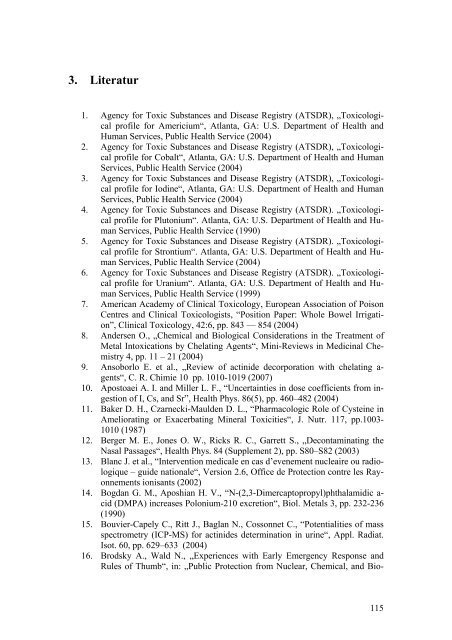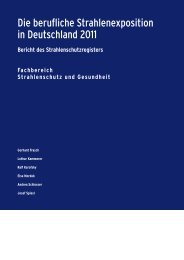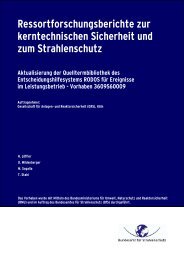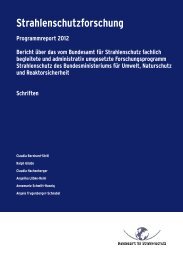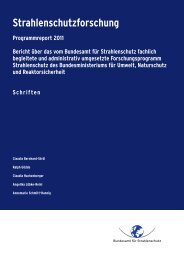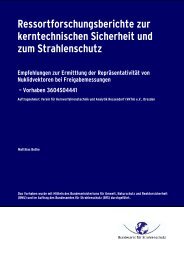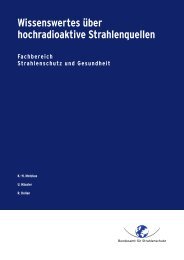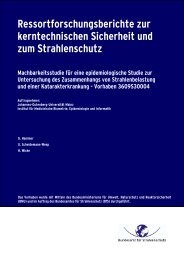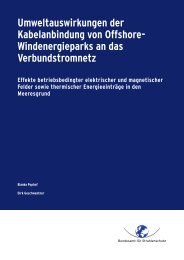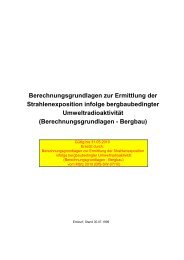Materialsammlung zur internen Radiodekontamination von Personen
Materialsammlung zur internen Radiodekontamination von Personen
Materialsammlung zur internen Radiodekontamination von Personen
Sie wollen auch ein ePaper? Erhöhen Sie die Reichweite Ihrer Titel.
YUMPU macht aus Druck-PDFs automatisch weboptimierte ePaper, die Google liebt.
3. Literatur<br />
1. Agency for Toxic Substances and Disease Registry (ATSDR), „Toxicological<br />
profile for Americium“, Atlanta, GA: U.S. Department of Health and<br />
Human Services, Public Health Service (2004)<br />
2. Agency for Toxic Substances and Disease Registry (ATSDR), „Toxicological<br />
profile for Cobalt“, Atlanta, GA: U.S. Department of Health and Human<br />
Services, Public Health Service (2004)<br />
3. Agency for Toxic Substances and Disease Registry (ATSDR), „Toxicological<br />
profile for Iodine“, Atlanta, GA: U.S. Department of Health and Human<br />
Services, Public Health Service (2004)<br />
4. Agency for Toxic Substances and Disease Registry (ATSDR). „Toxicological<br />
profile for Plutonium“. Atlanta, GA: U.S. Department of Health and Human<br />
Services, Public Health Service (1990)<br />
5. Agency for Toxic Substances and Disease Registry (ATSDR). „Toxicological<br />
profile for Strontium“. Atlanta, GA: U.S. Department of Health and Human<br />
Services, Public Health Service (2004)<br />
6. Agency for Toxic Substances and Disease Registry (ATSDR). „Toxicological<br />
profile for Uranium“. Atlanta, GA: U.S. Department of Health and Human<br />
Services, Public Health Service (1999)<br />
7. American Academy of Clinical Toxicology, European Association of Poison<br />
Centres and Clinical Toxicologists, “Position Paper: Whole Bowel Irrigation”,<br />
Clinical Toxicology, 42:6, pp. 843 — 854 (2004)<br />
8. Andersen O., „Chemical and Biological Considerations in the Treatment of<br />
Metal Intoxications by Chelating Agents“, Mini-Reviews in Medicinal Chemistry<br />
4, pp. 11 – 21 (2004)<br />
9. Ansoborlo E. et al., „Review of actinide decorporation with chelating agents“,<br />
C. R. Chimie 10 pp. 1010-1019 (2007)<br />
10. Apostoaei A. I. and Miller L. F., “Uncertainties in dose coefficients from ingestion<br />
of I, Cs, and Sr”, Health Phys. 86(5), pp. 460–482 (2004)<br />
11. Baker D. H., Czarnecki-Maulden D. L., “Pharmacologic Role of Cysteine in<br />
Ameliorating or Exacerbating Mineral Toxicities“, J. Nutr. 117, pp.1003-<br />
1010 (1987)<br />
12. Berger M. E., Jones O. W., Ricks R. C., Garrett S., „Decontaminating the<br />
Nasal Passages“, Health Phys. 84 (Supplement 2), pp. S80–S82 (2003)<br />
13. Blanc J. et al., “Intervention medicale en cas d’evenement nucleaire ou radiologique<br />
– guide nationale“, Version 2.6, Office de Protection contre les Rayonnements<br />
ionisants (2002)<br />
14. Bogdan G. M., Aposhian H. V., “N-(2,3-Dimercaptopropyl)phthalamidic acid<br />
(DMPA) increases Polonium-210 excretion“, Biol. Metals 3, pp. 232-236<br />
(1990)<br />
15. Bouvier-Capely C., Ritt J., Baglan N., Cossonnet C., “Potentialities of mass<br />
spectrometry (ICP-MS) for actinides determination in urine“, Appl. Radiat.<br />
Isot. 60, pp. 629–633 (2004)<br />
16. Brodsky A., Wald N., „Experiences with Early Emergency Response and<br />
Rules of Thumb“, in: „Public Protection from Nuclear, Chemical, and Bio-<br />
115


